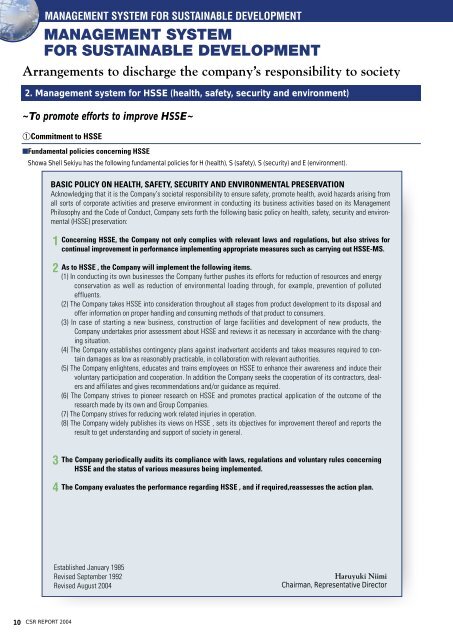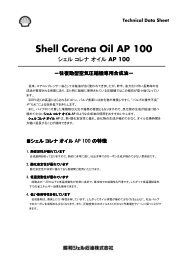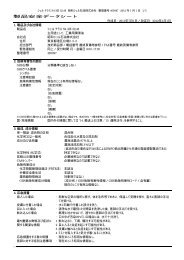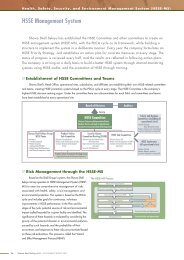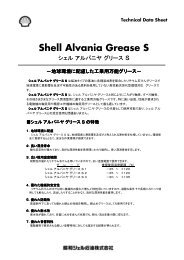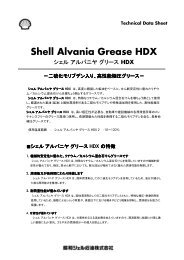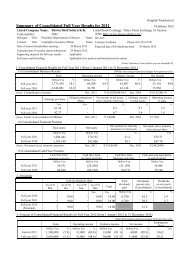MANAGEMENT SYSTEM FOR SUSTAINABLE DEVELOPMENT
MANAGEMENT SYSTEM FOR SUSTAINABLE DEVELOPMENT
MANAGEMENT SYSTEM FOR SUSTAINABLE DEVELOPMENT
Create successful ePaper yourself
Turn your PDF publications into a flip-book with our unique Google optimized e-Paper software.
10 CSR REPORT 2004<br />
<strong>MANAGEMENT</strong> <strong>SYSTEM</strong> <strong>FOR</strong> <strong>SUSTAINABLE</strong> <strong>DEVELOPMENT</strong><br />
<strong>MANAGEMENT</strong> <strong>SYSTEM</strong><br />
<strong>FOR</strong> <strong>SUSTAINABLE</strong> <strong>DEVELOPMENT</strong><br />
Arrangements to discharge the company’s responsibility to society<br />
2. Management system for HSSE (health, safety, security and environment)<br />
~To promote efforts to improve HSSE~<br />
➀Commitment to HSSE<br />
■Fundamental policies concerning HSSE<br />
Showa Shell Sekiyu has the following fundamental policies for H (health), S (safety), S (security) and E (environment).<br />
BASIC POLICY ON HEALTH, SAFETY, SECURITY AND ENVIRONMENTAL PRESERVATION<br />
Acknowledging that it is the Company’s societal responsibility to ensure safety, promote health, avoid hazards arising from<br />
all sorts of corporate activities and preserve environment in conducting its business activities based on its Management<br />
Philosophy and the Code of Conduct, Company sets forth the following basic policy on health, safety, security and environmental<br />
(HSSE) preservation:<br />
1<br />
2<br />
3<br />
4<br />
Concerning HSSE, the Company not only complies with relevant laws and regulations, but also strives for<br />
continual improvement in performance implementing appropriate measures such as carrying out HSSE-MS.<br />
As to HSSE , the Company will implement the following items.<br />
(1) In conducting its own businesses the Company further pushes its efforts for reduction of resources and energy<br />
conservation as well as reduction of environmental loading through, for example, prevention of polluted<br />
effluents.<br />
(2) The Company takes HSSE into consideration throughout all stages from product development to its disposal and<br />
offer information on proper handling and consuming methods of that product to consumers.<br />
(3) In case of starting a new business, construction of large facilities and development of new products, the<br />
Company undertakes prior assessment about HSSE and reviews it as necessary in accordance with the changing<br />
situation.<br />
(4) The Company establishes contingency plans against inadvertent accidents and takes measures required to contain<br />
damages as low as reasonably practicable, in collaboration with relevant authorities.<br />
(5) The Company enlightens, educates and trains employees on HSSE to enhance their awareness and induce their<br />
voluntary participation and cooperation. In addition the Company seeks the cooperation of its contractors, dealers<br />
and affiliates and gives recommendations and/or guidance as required.<br />
(6) The Company strives to pioneer research on HSSE and promotes practical application of the outcome of the<br />
research made by its own and Group Companies.<br />
(7) The Company strives for reducing work related injuries in operation.<br />
(8) The Company widely publishes its views on HSSE , sets its objectives for improvement thereof and reports the<br />
result to get understanding and support of society in general.<br />
The Company periodically audits its compliance with laws, regulations and voluntary rules concerning<br />
HSSE and the status of various measures being implemented.<br />
The Company evaluates the performance regarding HSSE , and if required,reassesses the action plan.<br />
Established January 1985<br />
Revised September 1992<br />
Revised August 2004<br />
Haruyuki Niimi<br />
Chairman, Representative Director
12 CSR REPORT 2004<br />
<strong>MANAGEMENT</strong> <strong>SYSTEM</strong> <strong>FOR</strong> <strong>SUSTAINABLE</strong> <strong>DEVELOPMENT</strong><br />
<strong>MANAGEMENT</strong> <strong>SYSTEM</strong><br />
<strong>FOR</strong> <strong>SUSTAINABLE</strong> <strong>DEVELOPMENT</strong><br />
■HSSE-MS framework (as of February 2004)<br />
Showa Shell Sekiyu’s HSSE-MS<br />
Refineries’ MS<br />
Showa Yokkaichi Sekiyu Co., Ltd.,<br />
Toa Oil Co., Ltd., Seibu Oil Co., Ltd.<br />
Distribution & Operations HSE-MS<br />
Sales Operations HSE-MS<br />
Lubricants & Bitument HSE-MS<br />
LPG HSE-MS<br />
Retail Sales HSE-MS<br />
Central Laboratory HSE-MS<br />
Research & Development HSE-MS<br />
International Sales HSE-MS<br />
New Business Development HSE-MS<br />
Products Trading HSE-MS<br />
Commercial Sales HSE-MS<br />
Niigata Petroleum Product<br />
Import Terminal HSE-MS<br />
Showa Shell Sempaku K.K. HSE-MS<br />
Shoseki Engineering &<br />
Construction Co., Ltd. HSE-MS<br />
Niigata Joint<br />
Oil Stockpiling Co.,Ltd HSE-MS<br />
Oil Tanks HSE Case<br />
Kushiro Nishi, Shiogama, Sado,<br />
Takasaki, Hiroshima, Karatsu, Hamada<br />
JONET Depot HSE Case<br />
Tomakomai, Hachinohe, Aomori, Matsumoto, Shimizu,<br />
Kokura, Fukui, Fukuoka, Yatsushiro<br />
East Ogishima Oil Terminal K.K. HSE Case<br />
Ocean Transport HSE Case<br />
In-Land Transport HSE Case<br />
Operation Sites HSE-MS/ Case<br />
Yokohama Site, Kobe Site<br />
Mie Plant HSE Case<br />
Takamatsu Asphalt Terminal HSE Case<br />
Shoseki Kako K.K. HSE Case<br />
Nippon Grease Co., Ltd. HSE Case<br />
Rekisei Kagaku K.K. HSE Case<br />
Hekinan LPG Terminal HSE Case<br />
Shimizu LPG Terminal HSE Case<br />
Shoseki Gas K.K. HSE Case<br />
Shoseki Home Gas K.K. HSE-MS/Case<br />
Service Stations (SS) HSE case<br />
Siris, Chuo Shell, Nakagawa Sekiyu, Shinyo Sekiyu, Axum, Sun road, Hayawa, Nisho Koyu,<br />
Chuseki Oil, Shell Tokuhatsu, Kyokuyo, Marushin, Dia Shoseki, Stella Hygo, Iwamura<br />
Bussan, Shoseki Shoji, Anzen Sekiyu, Hayashi Bussan, Kyoritsu Shoji, Nagano Sekiyu,<br />
Mieseki Shoji, Petrostar Kansai, Tokyo Shellpack, Central Energy, Petrostar Kanto, Osaka<br />
Shellpack, Oita Kaijirushi Sekiyu, Shell Sekiyu Osaka Hatsubaisho, Petrostar Hokuriku<br />
Central Laboratory HSE Case<br />
Hydrogen Station HSE Case<br />
Aircraft/Ship HSE Case<br />
Shell Solar Japan Saku Plant HSE Case<br />
Niigata Petroleum Product Import Terminal HSE Case<br />
Showa Shell Sempaku HSE Case<br />
Shoseki Engineering HSE Case<br />
Niigata Joint Oil Stockpiling HSE Case<br />
Note 1: HSSE Case means an HSSE-MS covering a specific facility or operation.<br />
Note 2: The above-illustrated framework also includes a unit where an HSSE-MS or HSSE Case is under development or revision.<br />
Note 3: An HSE-MS is operated as an HSSE-MS by incorporating security (S) into the scope of management.<br />
The revision of an HSE-MS or Case to an HSSE-MS or Case is now underway at each unit.
■HSSE internal audit<br />
The divisions of Showa Shell Sekiyu and its group companies<br />
have introduced HSSE management systems or HSSE cases<br />
applied to specific operation sites or facilities. Audits are conducted as<br />
a step to check whether the PDCA cycle functions properly in these<br />
systems. Audits include those conducted internally within the<br />
■Systematic development of HSSE-related regulations<br />
In our company, various activities relating to HSSE are defined in<br />
internal regulations developed specifically for the purposes. These<br />
regulations as a whole realize HSSE management, maintaining<br />
their relations as designed. Therefore, we should maintain the<br />
integrity of the system by ensuring the consistency of individual<br />
regulations and clarifying their relations with each other.<br />
■Acquisition of ISO14001 certification (as of March 2004)<br />
Prior to the development of an HSSE management system, the<br />
group’s refineries are acquiring, international environmental<br />
management system, ISO14001 certification. The company is<br />
Refineries, operation sites, affiliates Date of registration Applicable standard Accrediting organ Certification No.<br />
Seibu Oil Co., Ltd. Yamaguchi refinery 1998.12.10 ISO14001 LRQA 771922<br />
Showa Yokkaichi Sekiyu Co., Ltd.<br />
Yokkaichi refinery<br />
1999.07.29 ISO14001 LRQA 772522<br />
Toa Oil Co., Ltd. Keihin refinery 1999.06.18 ISO14001 LRQA 772510<br />
Showa Shell Sekiyu K.K. Hekinan LPG terminal 2001.12.21 ISO14001 KHK ISO CENTER 01ER-178<br />
K.K. SVC Tokyo 2001.01.23 ISO14001 JET-EC E00-165<br />
Japan Oil Network Co., Ltd. 2002.12.15 ISO14001 JQA-ISO CENTER JQA-EM1178<br />
■Definition and scope of group companies<br />
•For the purpose of management of HSSE-related affairs, the following companies are regarded as group companies.<br />
(As of February 2004)<br />
Showa Shell Sekiyu K.K.<br />
Showa Yokkaichi Sekiyu Co., Ltd. Toa Oil Co., Ltd. Seibu Oil Co., Ltd. Showa Shell Sempaku K.K. Siris Co., Ltd. Niigata Joint<br />
Oil Stockpiling Co., Ltd. Japan Oil Network Co., Ltd. Shoseki Kako K.K. Rekisei Kagaku K.K. Shoseki Gas K.K. Shoseki<br />
Engineering & Construction Co., Ltd. East Ogishima Oil Terminal K.K. Nippon Grease Co., Ltd. K.K. SVC Tokyo Chuo Shell Sekiyu<br />
Hanbai K.K. Marushin K.K. Petrostar Kansai K.K. Kitamoto K.K. K.K. Stella Hyogo<br />
K.K. Axum Chuseki Oil Osaka Shell pack K.K. Central Energy K.K. Kyokuyo Co., Ltd. Shouseki Shoji K.K. K.K. Shinyo Sekiyu<br />
Tokyo Shell pack K.K. Petrostar Kanto Co., Ltd. Nakagawa Sekiyu Hayakawa Dia Shoseki K.K. Shell Tokuhatsu K.K. Nissho<br />
Koyu K.K.<br />
■Performance report<br />
The group companies report all their HSSE-related performance to<br />
Showa Shell Sekiyu. HSSE related performance means accidents,<br />
health problems and security problems associated with business<br />
operations and environment-related data. The company does not<br />
■HSSE-related regulation system<br />
HSSE<br />
management regulations<br />
division and those conducted by the Environment Safety (HSSE)<br />
Department of Showa Shell Sekiyu. Audits conducted by the<br />
Environment Safety (HSSE) Department are performed regularly at<br />
prescribed intervals and provide advice for HSSE performance<br />
improvement.<br />
HSSE committee regulations HSSE sub-committee rules<br />
HSSE-MS<br />
HEMP analysis manual<br />
Accident report rules<br />
Divisional HSE-MS and Case<br />
(controlled by individual divisions)<br />
HSSE audit rules<br />
HSSE accident report manual<br />
Disaster control headquarters rules<br />
Safety merit commendation rules<br />
Accident survey committee rules<br />
Product safety regulations<br />
Product safety sub-committee rules<br />
(controlled by R&D Department)<br />
Safety and<br />
hygiene management regulations (controlled by Human Resource Department)<br />
Green purchase guidelines<br />
Animal experiment guidelines<br />
(controlled by Procurement Team)<br />
Security standards<br />
Disaster and theft prevention management rules<br />
MHMS<br />
Occupational disease report manual<br />
Health risk assessment manual<br />
developing an HSSE-MS, taking its consistency with ISO14001<br />
into consideration.<br />
only identify the group’s HSSE-related activity statuses from the<br />
collected data, but also utilizes them for the prevention of<br />
recurrences, etc.<br />
CSR REPORT 2004 13
14 CSR REPORT 2004<br />
<strong>MANAGEMENT</strong> <strong>SYSTEM</strong> <strong>FOR</strong> <strong>SUSTAINABLE</strong> <strong>DEVELOPMENT</strong><br />
<strong>MANAGEMENT</strong> <strong>SYSTEM</strong><br />
<strong>FOR</strong> <strong>SUSTAINABLE</strong> <strong>DEVELOPMENT</strong><br />
Arrangements to discharge the company’s responsibility to society<br />
3. Risk management and crisis management system<br />
~To implement risk and crisis management~<br />
➀The company’s effort for risk management<br />
■Business risk management system and risk management through HSSE management system<br />
As a means for internal control, the company has introduced a<br />
business risk management system, in which risks associated<br />
with Showa Shell Sekiyu’s business operations are identified for<br />
the entire company operations every year and the management as a<br />
whole recognizes and at the same time verifies critical risks and<br />
➁Risk management system for disaster control<br />
■Management system for disaster control<br />
Operation safety is one of the company’s responsibilities to<br />
society. Particularly in the petroleum industry, a failure in this<br />
aspect can result in a serious accident such as a fire, spill or<br />
explosion endangering the lives and properties of residents in the<br />
neighborhood, so we take the utmost care in developing our<br />
disaster prevention system.<br />
■Organization of the disaster control headquarters<br />
Disaster Control<br />
Headquarters<br />
Chief of the headquarters:<br />
HSSE Committee Chairman<br />
Deputy chief of the headquarters:<br />
director appointed by the chief<br />
Deputy chief of the headquarters:<br />
head of Environment Safety<br />
(HSSE) Department<br />
Financial Team Leader<br />
Liaison Team Leader<br />
Legal Affairs Team Leader<br />
Information Control Team Leader<br />
Rescue/Dispatch Team Leader<br />
Material/Construction Work Team Leader<br />
General Affairs Team Leader<br />
Public Affairs Team Leader<br />
■Counteractions formulated<br />
by a trans-departmental organization<br />
Disaster control, crisis management in particular, cannot be left in the<br />
hand of a single department. For this reason, we have developed a<br />
trans-departmental organization to involve all relevant divisions of the<br />
company to study possible counteractions broadly. The organization<br />
named as the Security Liaison Committee Meeting (SLCM) designed<br />
specifically for this purpose is developing specific disaster control<br />
measures including the distribution of handbooks setting forth<br />
behavioral norms requiring employees’ observation in an emergency and<br />
the method of ascertaining information on employees’ safety<br />
including their families’.<br />
■An effort to ensure security measures meeting the revised<br />
SOLAS convention requirements<br />
Triggered by the 9-11, multiple terrorists’ attacks in the U.S., the<br />
International Convention for the Safety of Life at Sea (SOLAS) was<br />
revised to enhance counter terrorism measures and enhanced security<br />
arrangements were put into effect on July 1 2004 at all international<br />
port facilities.2004 at all international port facilities.<br />
In Japan, which imports almost all oil from overseas, we are<br />
formulate action plans. As for HSSE risks in particular among the<br />
business risks, strict control under the HSSE management system is<br />
implemented so that the company can avoid impediments to<br />
business before they actually take shape or minimize their impacts on<br />
business even if they actually take shape.<br />
Emergency arrangements are specified in the relevant internal<br />
regulations to prepare for a time of need, and we are endeavoring to<br />
develop system to minimize damages from disaster by establishing the<br />
disaster control headquarters, improving divisional arrangements<br />
to cope with emergencies and updating emergency call chains<br />
regularly.<br />
Financial Department<br />
Corporate Planning<br />
Department<br />
Legal Affairs Office<br />
Department in<br />
charge of the accident site<br />
Human Resource Department<br />
Procurement Team<br />
General Affairs Department<br />
Public Affairs Office<br />
Field disaster<br />
control headquarters<br />
Divisional disaster<br />
control headquarters<br />
Organizations specified by divisions<br />
required to prevent terrorists’ attacks on oil-related facilities<br />
erected at ports and ensure the safety of neighboring areas and a<br />
stable supply of petroleum energy. In this regard, we think it is very<br />
important to put appropriate security measures in place to<br />
safeguard sea berths and wharfs constructed in international port<br />
facilities for receiving oil from overseas.<br />
Showa Shell Group companies engaged in the management of<br />
international port facilities have taken security measures including the<br />
following depending on the conditions such as facility locations,<br />
security levels, etc. in its effort to enhance security under the<br />
guidance of the relevant authorities so that they can fulfill their<br />
assigned tasks:<br />
•Development of facilities to stop adversities’ access to<br />
controlled areas<br />
•Establishment of constant surveillance system and emergency<br />
police notification system<br />
•Implementation of staff training and joint training with<br />
relevant organizations<br />
•Reporting the appointment of a wharf security manager and<br />
acquiring approval of wharf security regulations
■Disaster control system in a time of need<br />
Firefighting at refineries and oil tanks<br />
At the refineries and oil tanks of the group, almost all processes are fully<br />
controlled with state-of-the-art computers operated under a centralized,<br />
around-the-clock monitoring system and equipped with fire extinguishers. In<br />
addition, refineries have disaster control equipment including large<br />
chemical fire engines on their premises and self-defense fire brigades<br />
consisting of firefighters selected from employees to prepare for an<br />
emergency.<br />
Actual firefighting training conducted<br />
at the Niigata Disaster control training center<br />
Generally it is believed to be of extreme importance to carry out<br />
initial-stage firefighting activity in an expeditious and apt manner when<br />
a fire breaks out. The same applies to a refinery fire, but a fire at a<br />
refinery is generally chemical fire, which requires appropriate<br />
professional knowledge and skills in fighting fire. For this reason,<br />
Showa Shell Sekiyu opened a disaster control training center in the<br />
Niigata Petroleum Product Import Terminal in April 1993 and gives<br />
actual firefighting training to members of its fire defense forces<br />
organized at the respective locations to help strengthen initial<br />
firefighting capability of its operation sites all over the country.<br />
At this disaster control training center, our employees working in<br />
a refinery, an operation site, a terminal, an oil tank or the group’s other<br />
facility master elementary firefighting knowledge and skills to<br />
control an initial-stage oil fire through training using model<br />
facilities. The training center has an oil tank, pump, drum, piping of<br />
various kinds, LPG tank, tank lorry, etc. like our actual operation<br />
sites and gives training, in a practical manner giving priority to<br />
safety, on the disaster control/firefighting methods most suitable<br />
for the respective fire types by simulating the most likely fire types<br />
assumed for actual operation sites by facility. This training center is<br />
established as an organization placed under the control of HSSE<br />
Department of the head office, which promotes earnest efforts for<br />
disaster prevention under a unified intention as the group with its staff<br />
members taking part in training as lecturers instructing basic<br />
stances toward disaster control as well as assisting actual<br />
firefighting training. Since its foundation, the training center has<br />
given training to approximately 1,800 employees in 12 years,<br />
contributing to the discernible improvement in their consciousness of<br />
disaster control and firefighting skills.<br />
Local community exchange through disaster prevention<br />
This disaster control training center receives a number of visitors in<br />
succession from various organs including government departments,<br />
local fire stations, schools and mass media, which indicates<br />
people’s strong interest in disaster prevention. Our employees<br />
trained in this training center play an leading role in disaster<br />
control training at operation sites, while they participate in<br />
firefighting training organized by local town block associations<br />
from time to time to ensure close communication with local<br />
communities and uphold people’s consciousness of fire prevention.<br />
■Actions to prevent ocean pollution<br />
Adoption of a double hull construction for ocean-going oil tankers<br />
Following the accident of the Exxon Valdez spilling 40,000kl of oil near<br />
the Alaskan coast in 1989, a double hull construction to arrange<br />
seawater ballast tanks on the bottom and sides of a ship was<br />
adopted as an internationally agreed standard.<br />
As a result of the adoption of a double hull construction, even if<br />
a ship’s exterior shell is damaged upon collision or contact, cargo fuel<br />
loaded in the vessel is protected and a spill of fuel, etc. into the ocean<br />
is minimized as its effect.<br />
At the Showa Shell Group, we have been promoting the<br />
conversion to a double hull construction with completion targeted in<br />
2008 and we have already converted 8 out of the 9 vessels we<br />
charter to a double hull construction, continuing our efforts to<br />
convert all of them as quickly as possible.<br />
Crude oil tankers are obliged to the equipment of separate<br />
ballast tanks and no seawater is introduced into crude oil tanks<br />
any more. Thus, the problem of dirty ballast has been solved and the<br />
adoption of a double hull construction, which allows the outer shell to<br />
be used as ballast tanks, also contributed significantly in solving<br />
this problem.<br />
Anti-oil pollution equipment/material stock points<br />
(#4 stock point)<br />
The Petroleum Association of Japan has established anti-oil<br />
pollution equipment/material stock points at 6 places in Japan and 5<br />
places in the Middle East and the Southeast Asia to prepare for a<br />
large-scale oil spill accident. Showa Shell Sekiyu supports this<br />
Association’s initiative by offering a part of its Niigata Petroleum<br />
Product Import Terminal premises for use as an anti-oil pollution<br />
equipment/material stock point (#4 stock point).<br />
In these stock points, oil skimmers, oil fences and beach<br />
cleaners are stored. Such equipment includes some large, hightech<br />
machines, and the company assigns its employees to master<br />
equipment operations by giving them education and training.<br />
Actual firefighting training at the disaster control training<br />
center in the Niigata Petroleum Product Import Terminal.<br />
#4 anti-oil pollution equipment/material stock point<br />
(in the Niigata Petroleum Product Import Terminal)<br />
CSR REPORT 2004 15


